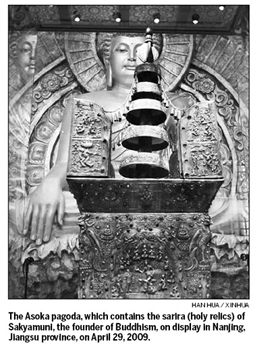-
News >China
Buddha's skull to be enshrined
2010-06-11 11:06BEIJING - A sarira believed to have been made from the skull of Sakyamuni - the founder of Buddhism - will be enshrined in Qixia Temple in Jiangsu province's capital Nanjing on Saturday morning.
The temple said Buddhist monks and archaeologists will unveil the relic for the first time in the more than 1,000 years it has been stored in an Asoka pagoda.The pagoda contains the only known part of Sakyamuni's skull, said Qi Haining, an expert with Nanjing Museum and head of the archaeological team responsible for its discovery.
Buddhist monks will then enshrine the sarira in a case that will ensure a stable temperature and humidity.
Archaeologists will document the entire process with photographs and videos, which they will show at a news conference in the afternoon at Nanjing Museum. They will also brief the public on the process of discovering the artifact and why they believe it belongs to Sakyamuni.
Phoenix TV and Nanjing TV will broadcast the entire event live.
Local authorities have promised tight security to ensure the safety of the sarira, which Buddhists all over the world regard as holy.

It is said that 2,500 years ago, Sakyamuni's disciples retrieved from his cremation one skull bone, two scapulas, four teeth and 84,000 pearl-like sariras.
According to Buddhist records, Asoka, an Indian emperor who converted after a bloody war, collected all of Sakyamuni's sarira. He stored them in pagoda-shaped shrines before sending them to different parts of the world. China is believed to have received 19 of them.
The discovery of the sarira to be enshrined on Saturday has been an exhilarating archaeological experience.
It started in July 2008, when archaeologists set out to excavate the ruins of Nanjing's Changgan Temple, built in the Song Dynasty (AD 960-1279).
They unearthed a stele with an inscription, reading, "A Seven-Treasure Pagoda of King Asoka" that contained a miniature gold coffin nested inside a silver one. The gold casket holds Sakyamuni's sarira.
Archaeologists were excited to find the record on the stele conforms with historical records of an Asoka pagoda buried under the Changgan Temple, the second temple in China that received and housed Sakyamuni's sarira.
However, their most exciting moment came last August, when they excavated from the temple a wooden Asoka pagoda covered with gilded silver and inlaid with "seven treasures", including gold, silver, colored glaze, agate and amber.
The pagoda contained the nested coffins with the Sakyamuni relic inside. But it took the team another year to excavate and verify the artifacts.
Related News:
